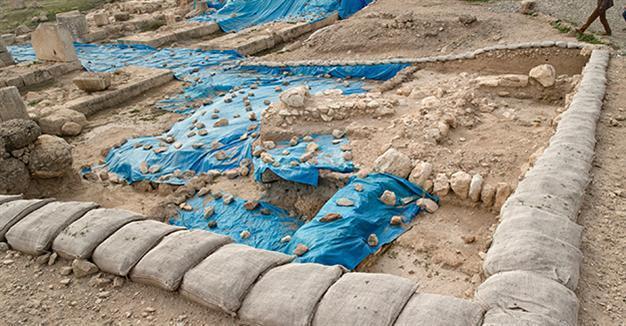Ancient Karkamış sees modern war on Turkey-Syria border
GAZİANTEP – The Associated Press

AP photo
The tourist gate and ticket house are ready at the ancient city of Karkamış, where Turkish troops crossed last month into Syria and ousted Islamic State of Iraq and the Levant (ISIL) militants from the border.Despite Syria’s civil war, archaeologists on the Turkish side of border-straddling Karkamış unearthed sculptures, mosaics and other artifacts in relative safety although sporadic gunfire and shelling was occasionally audible from the Syrian side. Now they plan to open the remains of the strategic city from the Hittite era to the public next year, despite the proximity of conflict in neighboring Syria.
Such are the modern fortunes of Karkamış, which dates back thousands of years and was excavated before World War I by British archaeologists including T.E. Lawrence, later known as Lawrence of Arabia. A century later, the area was demined and a Turkish-Italian team started work at the site controlled by the Turkish military.
Then came Turkey’s Aug. 24 military incursion into Syria from the Karkamış area, which could ease security worries about the archaeological park on the Euphrates. Its opening, delayed several times, is scheduled for May 2017.
“The situation is definitely more favorable to tourism,” said Nicolo Marchetti, a professor of archaeology and art history of the Ancient Near East at the University of Bologna and project director at Karkamış on the Turkish side.
The February construction of a protective, 1.7-kilometer wall on the border, stretching from the train station of the modern town of Karkamış to a railway bridge built by Germans a century ago, was required for the tourist project, Marchetti said.
The prefabricated wall “can be removed swiftly if peace breaks out,” he said.
The remains of the citadel and inner town are on the Turkish side, where the most valuable archaeological items of Karkamış lie. But part of the ancient outer town is in the Syrian town of Jarablus, held by ISIL militants until Turkish ground forces occupied the area.
Marchetti expressed concern about what he called “a void of responsibility” for protection of archaeological heritage on the Syrian side of Karkamış.
Turkey is a party to a 1954 Hague agreement calling for the protection of cultural heritage during armed conflict.
Syria’s lawlessness has already fueled widespread looting of artifacts, some of it by ISIL militants who have also destroyed ancient statues and structures, notably in the ancient town of Palmyra. Russia built what it called a “temporary” military encampment inside a zone that holds the UNESCO world heritage site in Palmyra after militants were driven out earlier this year.
In western Syria, Syrian government forces have used archaeological sites, cutting holes in mounds dating from ancient communities and using them to protect tanks and personnel from any attack from the other side, according to Dan Lawrence, a lecturer in the archaeology department at Durham University in Britain.
A lot of archaeological material on the Syrian side of Karkamış is especially vulnerable because it is just below the ground surface, said Lawrence, adding that he saw video of Turkish tanks moving through Syrian areas where he worked before the civil war.
“Anything you do in that area will have a massive impact on the archaeology,” he said.
ISIL fighters tried to dig a large ditch through the Syrian side of Karkamış earlier this year, but a U.S.-led coalition aircraft destroyed their bulldozer, said Marchetti of the University of Bologna.
Echoing complex conflicts in the region many centuries ago, Turkey supports U.S. air strikes against ISIL while seeking to thwart U.S.-backed Kurdish forces, which are also fighting the Islamic extremists.
The Bible’s Jeremiah refers to Karkamış due to a battle there in which the Babylonians, led by Nebuchadnezzar II, defeated the Assyrians and their Egyptian allies.
In 1516, long after Karkamış’s demise, Ottoman imperial forces defeated Mamluk troops at the battle of Marj Dabiq near Aleppo, opening the way to Ottoman conquests in the Middle East. The battle’s date was Aug. 24, 500 years to the day before Turkey sent troops into Syria.
















